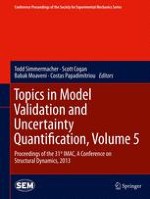2013 | Book
Topics in Model Validation and Uncertainty Quantification, Volume 5
Proceedings of the 31st IMAC, A Conference on Structural Dynamics, 2013
Editors: Todd Simmermacher, Scott Cogan, Babak Moaveni, Costas Papadimitriou
Publisher: Springer New York
Book Series : Conference Proceedings of the Society for Experimental Mechanics Series
